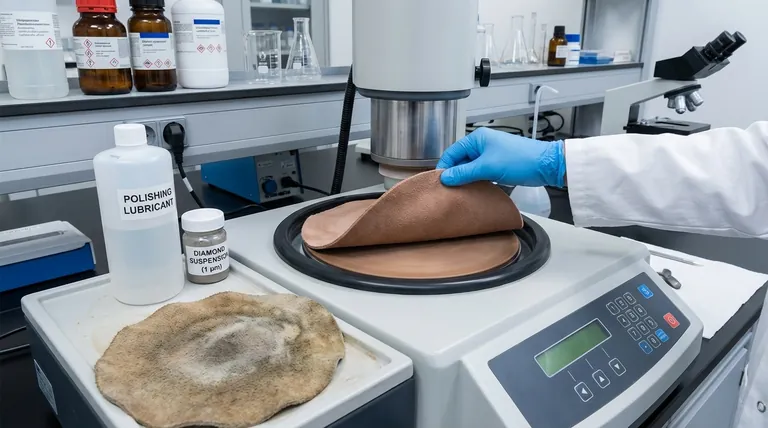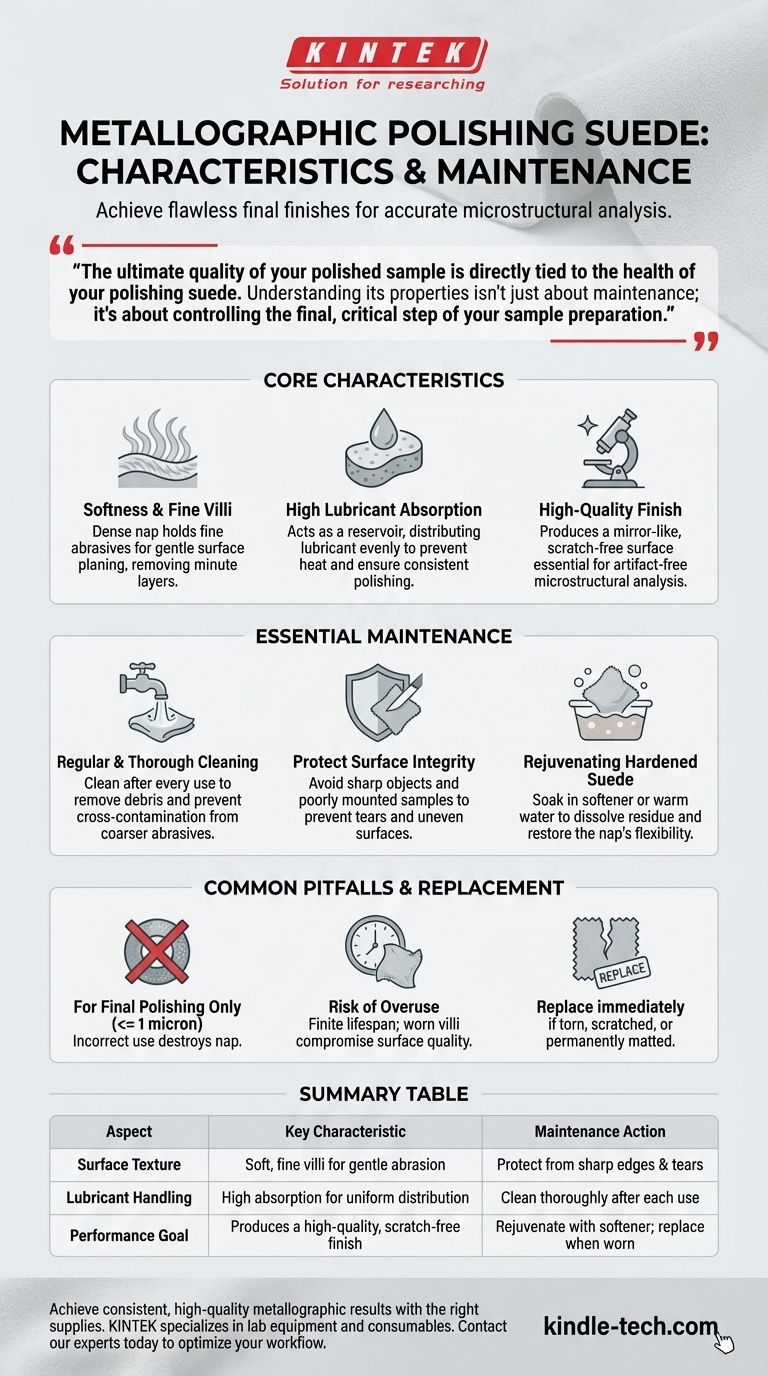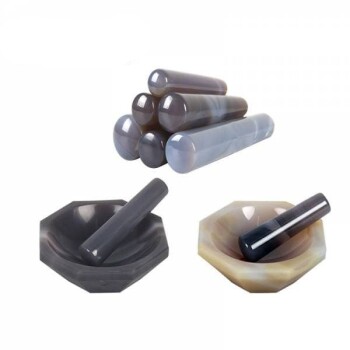For metallographic analysis, polishing suede is defined by its soft texture, fine villi, and excellent water absorption. These characteristics are essential for achieving a high-quality, artifact-free surface finish during the final polishing stages. Proper maintenance involves regular cleaning, protection from physical damage, and rejuvenation with a softener if the material hardens.
The ultimate quality of your polished sample is directly tied to the health of your polishing suede. Understanding its properties isn't just about maintenance; it's about controlling the final, critical step of your sample preparation to ensure accurate microstructural analysis.

The Core Characteristics of Polishing Suede
The specific properties of polishing suede are what make it indispensable for the final steps of metallographic sample preparation. Each characteristic serves a distinct purpose in achieving a damage-free surface.
Softness and Fine Villi
The suede's surface is composed of a dense nap of fine, soft fibers. This texture is critical for holding fine abrasive particles, such as diamond suspensions or colloidal silica.
Instead of rigidly gouging the sample, the soft villi allow the abrasive to gently plane the surface, effectively removing the last, minute layers of deformation from previous grinding steps.
High Lubricant Absorption
Polishing suede acts like a reservoir for the polishing lubricant or suspension. It absorbs and distributes the liquid evenly across its entire surface.
This ensures consistent lubrication between the cloth and the sample, which prevents heat buildup, minimizes dragging artifacts, and guarantees that fresh abrasive is always available at the point of contact.
The Result: A High-Quality Surface Finish
The combination of a soft nap and excellent lubricant retention allows the suede to produce a mirror-like finish that is free of scratches and deformation.
This pristine surface is essential for accurate analysis under a microscope, as it reveals the true microstructure of the material without artifacts introduced during preparation.
Essential Maintenance for Consistent Results
Improperly maintained polishing suede is a primary cause of failed sample preparation. Following a strict protocol ensures repeatable, high-quality outcomes.
Regular and Thorough Cleaning
After every use, the suede must be thoroughly cleaned with running water. This removes embedded abrasive particles and metallic debris from the sample.
Failure to clean the cloth properly will lead to cross-contamination. Coarser abrasive particles from a previous step will be dragged across the sample in the next step, creating deep scratches that ruin the final polish.
Protecting the Surface Integrity
The suede must be protected from sharp objects, including the edges of a poorly mounted or beveled sample. A tear or scratch in the cloth creates an uneven surface that will transfer to your sample.
A damaged nap can no longer hold lubricant or abrasive properly, leading to inconsistent polishing and artifacts.
Rejuvenating Hardened Suede
Over time, the buildup of dried lubricant and polishing compounds can cause the suede's villi to become matted and hard.
If the cloth loses its softness, it can often be rejuvenated by soaking it in a designated polishing cloth softener or warm water. This helps dissolve the residue and restore the nap's flexibility and effectiveness.
Understanding the Trade-offs and Common Pitfalls
While essential, polishing suede has specific limitations and is often a source of error if used incorrectly.
Suede Is for Final Polishing Only
This material is designed exclusively for final polishing steps, typically with abrasives that are 1 micron or smaller.
Using a suede cloth for coarse or intermediate grinding will destroy the nap instantly and will be completely ineffective at removing material. Always match the cloth type to the abrasive size and preparation stage.
The Risk of Overuse
A polishing cloth has a finite lifespan. Even with perfect cleaning, the villi will eventually wear down and become matted. An overused cloth loses its ability to hold abrasive and lubricant correctly, leading to a noticeable drop in surface quality.
Attempting to save costs by extending the life of a worn-out cloth is a false economy, as it often results in wasted time and rejected samples.
Knowing When to Replace the Cloth
The cloth must be replaced immediately if it is visibly torn, scratched, or has areas where the nap is permanently matted down.
If rejuvenation with a softener no longer restores the suede's soft, uniform texture, its useful life is over. Continuing to use it will compromise the integrity of your results.
Applying This to Your Metallographic Process
Your approach to suede maintenance should be guided by the specific goals of your lab work.
- If your primary focus is achieving a perfect finish for EBSD or atomic force microscopy: You must use dedicated suede cloths for each final polishing step to eliminate any risk of cross-contamination.
- If your primary focus is routine quality control with high throughput: Implement a strict cleaning protocol after every run and a clear schedule for rejuvenating or replacing cloths to maintain consistency across all samples.
- If you are troubleshooting persistent, fine scratching on your samples: Your first suspect should be a contaminated or worn-out polishing suede; replace it before re-evaluating other preparation parameters.
Proper care of your polishing suede is a small investment that protects the significant effort of your entire sample preparation workflow.
Summary Table:
| Aspect | Key Characteristic | Maintenance Action |
|---|---|---|
| Surface Texture | Soft, fine villi for gentle abrasion | Protect from sharp edges and tears |
| Lubricant Handling | High absorption for even distribution | Clean thoroughly after each use |
| Performance Goal | Produces a high-quality, scratch-free finish | Rejuvenate with softener; replace when worn |
Achieve consistent, high-quality metallographic results with the right supplies. Proper polishing suede is critical for a flawless final finish. KINTEK specializes in lab equipment and consumables, providing the reliable polishing cloths and maintenance products your laboratory needs for accurate microstructural analysis. Contact our experts today to discuss your specific sample preparation requirements and ensure your workflow is optimized for success.
Visual Guide

Related Products
- Metallographic Specimen Mounting Machine for Laboratory Materials and Analysis
- Laboratory Hybrid Tissue Grinding Mill
- Nature Agate Mortar and Pestle for Grinding and Mixing
- Laboratory Disc Rotary Mixer for Efficient Sample Mixing and Homogenization
- Customizable XRD Sample Holders for Diverse Research Applications
People Also Ask
- What is the general procedure and what precautions should be taken during the polishing process? Achieve a Flawless Electrode Finish
- How are samples prepared for XRF analysis? Achieve Accurate and Reliable Results
- How should an RVC sheet be handled and set up during an experiment? Ensure Precision and Data Integrity
- What is the difference between hot mounting and cold mounting? Choose the Right Method for Your Sample
- What are the samples for XRF analysis? A Guide to Preparing Solids, Powders, and Liquids








